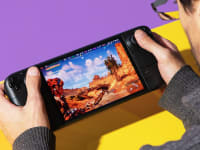Pros
-
Massive, attractive display
-
High build quality
-
Strong performance
Cons
-
Heavy and thick
-
Switch-like features don’t hit the mark
-
Mediocre software
About the Lenovo Legion Go
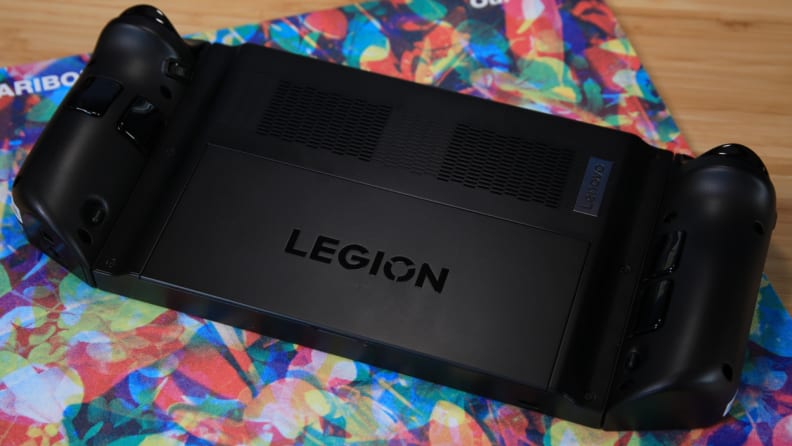
The Lenovo Legion Go has a built-in kickstand to keep it propped up if you don't want to hold it.
The Lenovo Legion Go is sold in just two flavors: a base $700 model with 512GB of solid-state storage and a step-up $750 model with 1TB of storage (although we've seen both models on sale for $50 off). We reviewed the 1TB model. All internal and external hardware is otherwise identical, so this review applies to both.
The Lenovo Legion Go has detachable controllers which, at a glance, seem to emulate the Nintendo Switch. Both the right and left sides are independently detachable and can be used wirelessly. The Legion Go can be enjoyed as a handheld, while docked, or used like a tiny portable monitor thanks to the integrated kickstand.
Lenovo Legion Go specs
- Price: $700 (512GB), $750 (1TB)
- Processor: AMD Ryzen Z1 Extreme 8-core/16-thread, max clock speed 5.1GHz
- Graphics: AMD Radeon Graphics with 12 Compute Units
- RAM: 16GB LPDDR5X-7500
- Storage: 1TB PCIe 4.0 2230 NVMe M.2 SSD
- Display: 8.8-inch, 2560 x 1440, adaptive sync IPS touchscreen, 144HZ refresh rate, 500 nits (rated), 1000:1 contrast ratio (rated)
- Wireless connectivity: Wi-Fi 6E, Bluetooth 5.1
- Ports: 2x USB 4 Type-C with DisplayPort 1.4 Alt-mode support, 3.5mm combo audio jack, MicroSD card reader
- Battery: 49.2Whr
- Weight: 1.88 pounds (854 grams)
- Dimensions: 11.76 x 5.16 x 1.6 inches (at thickest point)
- Additional features: Built-in touchpad, detachable TrueStrike controllers with FPS mode, bundled controller base, Hall effect joysticks, right-side macro buttons, built-in haptics and gyro, 2x 2-watt speakers, dual-array microphone
What we like
The massive display is a huge win
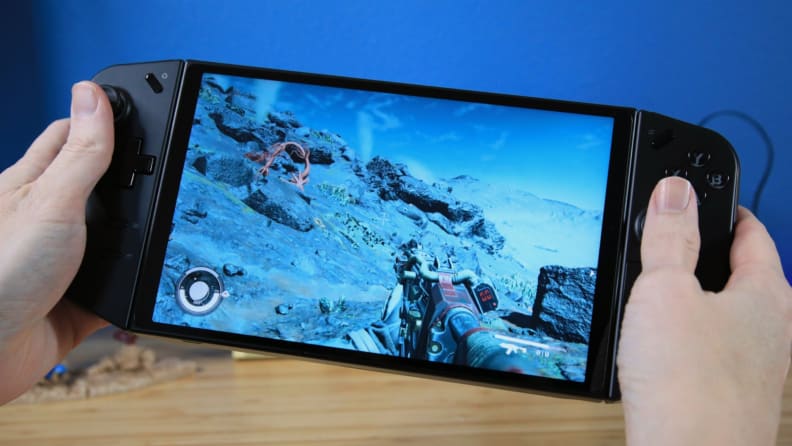
The high-refresh-rate screen and its resolution are nothing short of impressive.
The Lenovo Legion Go’s display is easily its best feature. It’s an immersive 8.8-inch IPS touchscreen with a native resolution of 2560 x 1440 and a maximum refresh rate of 144Hz. This is a tablet-class display. In fact, it’s half an inch larger than the screen on the current iPad Mini.
A large display offers a couple of practical perks. Most PC games are designed for larger screens, so small text can be hard to read on a handheld. The Legion Go doesn’t entirely solve this, but readability is certainly improved over smaller competitors. The touchscreen is more enjoyable, too, because in-game buttons are large and easy to tap.
Sharpness is another perk. The display’s 1440p resolution packs an impressive 333 pixels per inch (ppi), which is similar to many smartphones and tablets. Asus’s ROG Ally Z1 offers similar sharpness at 315ppi, but the Steam Deck OLED delivers just 194ppi. You won’t always notice the difference, as newer games must render at a much lower resolution to hit playable frame rates. But the Legion Go’s sharpness is an advantage for those who prefer playing 2D games or older 3D titles at a higher resolution.
The Legion Go’s display suffers one problem, and that’s contrast. The LCD panel has a backlight that’s always on, even when displaying what should be a blank, black screen. Scenes that should appear black instead seem hazy and gray. It’s not noticeable in games with a bright color palette, like World of Warcraft, but becomes an issue in darker, more atmospheric titles like Resident Evil 4.
Valve’s Steam Deck OLED undeniably beats the Legion Go in image quality, as it provides superior contrast and brightness. Still, I’d rather have the Go’s size over the OLED’s vibrance.
It looks and feels solid
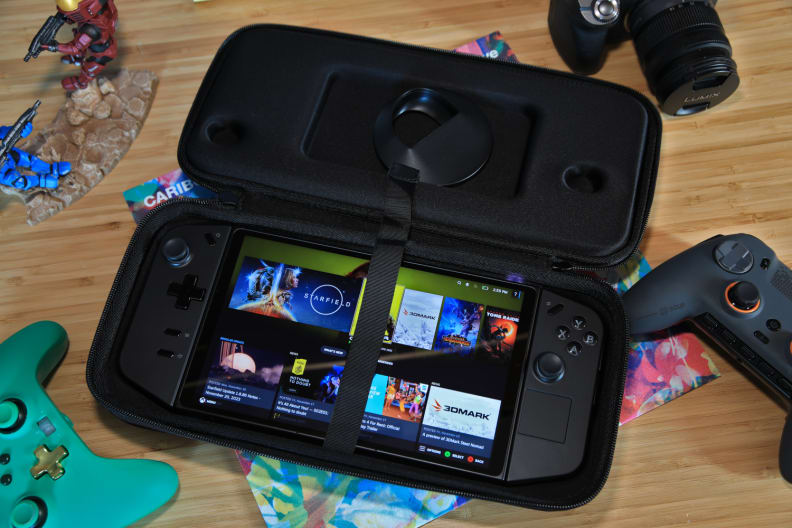
Like the Steam Deck, the Lenovo Legion Go comes with an included carrying case.
Lenovo’s engineers deserve a bonus for the Legion Go’s fit and finish. It’s the company’s first handheld yet delivers a polished, refined feel that’s right in line with Valve’s Steam Deck.
The rigidity stands out. Its size could’ve placed it at a disadvantage because a larger handheld needs more internal reinforcement to resist flex across its surface. Yet the Legion Go feels wonderfully stiff in hand. The buttons, joysticks, and touchpad are well-executed, too. They activate smoothly with no wobbles or groans.
I’m even more impressed by the detachable controllers. Making them detachable adds a weak spot in the design, but the Legion Go’s controllers are so solid they at first seem permanently attached. Applying extreme force will eventually cause them to wiggle and bend, but the strength required to do it is excessive. They’re easily removed with the tap of a button on the rear of the handheld and a gentle downward push.
Lenovo includes a well-designed kickstand that can prop up the display on a table or desk. The kickstand is broad and attached to the handheld with a sturdy hinge that doesn’t collapse if the Go is bumped or jostled.
Performance is strong, and even stronger when plugged in
The Lenovo Legion Go uses AMD’s Ryzen Z1 Extreme processor, a relatively new system-on-a-chip also found in the Asus ROG Ally Z1 Extreme. It packs an 8-core, 16-thread processor alongside AMD Radeon graphics with 12 compute units, a potent combination that delivers playable frame rates in most modern games.
When benchmarking in 3DMark Time Spy, using the Balanced (15-watt TDP) power profile on the Go led to a score of 2105 on battery, which slightly increased to 2378 when plugged in. Flipping the power profile to Performance (20-watt TDP) improved the scores to 2890 on battery power and 3117 plugged in.
These scores are virtually identical to the Asus ROG Ally Z1 Extreme, which tends to hover around 2400 in its 15-watt Performance profile and 3100 in its 25-watt Turbo mode. The Steam Deck OLED, meanwhile, lands around 1,600 to 1,700.
That’s a good result for the Legion Go. But what about in games?
Older titles, like World of Warcraft, Final Fantasy XIV, and Shadow of the Tomb Raider generally achieve 60 frames per second at 1080p resolution and medium-to-high detail. World of Warcraft can hit 60 FPS even at 1440p resolution, albeit with its detail slider reduced to 5 (out of 10).
Cyberpunk 2077, a notorious system killer, runs well. The game’s Steam Deck preset, which reduces most detail to low, sets a resolution of 1200 x 800, and engages AMD’s FSR image upscaler, hit an average of 35.4 frames per second with the Go in Balanced mode and on battery power. Plugging in the Go greatly improved performance, which averaged up to 60 frames per second when plugged in on Performance mode.
It’s a similar story in Starfield. I set the game to 720p resolution with FSR 2 engaged, all details set to Low, and a render scale of 50 percent. The resulting image was grainy but proved playable at an average of 32 frames per second on battery power with Balanced mode engaged. That average soared as high as 51 frames per second in Performance mode with power connected.
The same performance-to-image-quality tradeoffs are necessary with other handheld gaming PCs, however, and the Legion Go’s overall performance is impressive. It’s similar to the Asus ROG Ally Z1 Extreme and quicker than the Steam Deck (including the new OLED model). The Go is among the most capable devices in its class.
What we don’t like
Contrary to its name, the Go is best kept at home
The Legion Go is huge, massive, gigantic: a true absolute unit. Its size is necessary to house the beautiful 8.8-inch display but sinks any supposed portability.
It tips the scales at 1.88 pounds, almost half a pound more than the Asus ROG Ally Z1 or Steam Deck OLED. Half a pound looks light on paper, but you’ll feel every ounce. The Legion Go becomes tiring to hold for more than a few minutes. That’s bad news if you want to use it while in bed or reclining on a couch. It’s best used upright in a chair with armrests you can lean on to help support the Go’s weight.
It’s thick, too, measuring up to 1.6 inches at the thickest point, and even that doesn’t convey its size. The Legion Go’s blocky controllers place its thickest point under your palms. My hands found a passable grip but, at an inch over six feet tall, I’m larger than your average bear. People with smaller hands will find it unwieldy.
Then there’s the lack of battery life. The Legion Go’s 50-watt-hour battery is impressive for a device of its size (that’s larger than many small laptops), but 3D games drain it with shocking speed. Playing games in Performance mode can drain the battery in an hour flat. Expect one-and-a-half to two-and-a-half hours of battery life in most games.
The controls are a mixed bag
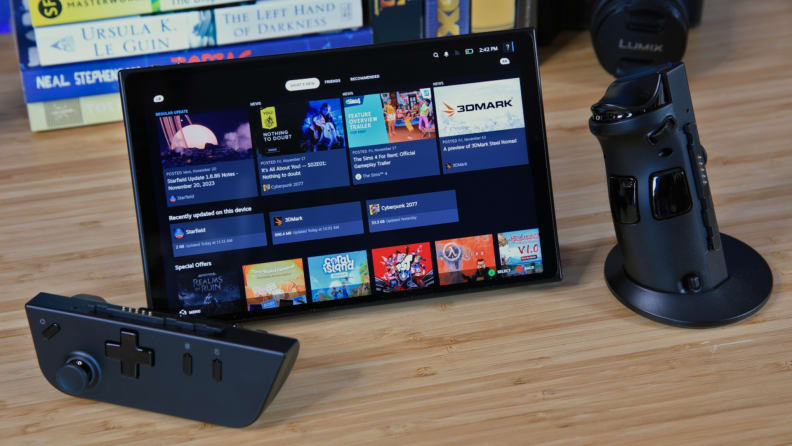
The unique FPS Mode is a bit of a whiff.
The Legion Go’s detachable controllers promise an experience similar to the Nintendo Switch. Yet, it’s not as versatile as it seems.
Though the Legion Go’s controllers are detachable, they differ from the Nintendo Switch’s Joy-Cons because they lack a grip to convert them to a standard gamepad. It’s possible to control a game while using the controllers wirelessly in separate hands, but my natural grip placed my fingers along the metal contacts used to charge the controller, which wasn’t comfortable. A third-party Bluetooth controller is a better option.
Lenovo tries to make up for that with FPS Mode, a unique feature that uses a plastic base to convert the right controller into a PC mouse (an optical sensor hides in the base of the right controller). It can be useful in games that lack gamepad support, like so-called “Boomer Shooters” based on Doom and Quake. But wow, the learning curve was steep. I spent more time flailing than I did targeting foes.
The Legion Go’s attempt to emulate the Switch doesn’t work, but the controllers work well when docked to the tablet. I found the joysticks comfortable and enjoyed the chunky, clunky feel of the face buttons and D-Pad. The triggers and shoulder buttons are well placed and the former activates with a smooth, crisp motion. My only complaint concerns two bonus buttons placed on the right controller. These sit below the shoulder button, and I found them easy to accidentally activate.
There’s a touchpad, too, which is placed below the right thumbstick. It’s small, measuring about an inch square, but its sensitivity is well-tuned to make the most of the limited space. Lenovo uses haptics to communicate when the touchpad is in use.
The software still needs some work
Handheld gaming PCs that use Windows 11 support a huge range of software and can even be used as a portable, dockable Windows desktop. Wrangling that experience into a handheld is tough, though, and a few problems remain.
Lenovo’s software experience revolves around Legion Space, a desktop UI replacement that launches automatically when the Legion Go boots into Windows. It offers easy-to-read buttons and thumbnails that work well when using the Go’s controllers or the touchscreen. Legion Space integrates with other platforms including Steam, Epic Games, and Xbox, adding games from each to its library. You can even add games by specifying a path to the .exe file.
The interface’s home screen is packed with advertising, though, which is drawn from multiple sources. It can be useful since it displays deals from multiple stores including Steam, Epic Games, and the Microsoft Store. Still, I expect most PC gamers will find it distracting. Removing the ads would be an easy win for Lenovo.
But, try as it might, the Legion Go can’t banish the Windows desktop. Legion Space helps launch games, but those that use a launcher (which many do) often drop into Windows to present it before the game can proceed. It’s also necessary to use Windows for fine-grain system adjustments like installing or troubleshooting drivers, installing game mods, and many other tasks.
None of this is Lenovo’s fault and, to its credit, the Legion Go’s software is quicker and more refined than what shipped on Asus’ ROG Ally Z1 and Z1 Extreme. The Legion Go is a Windows machine at heart and comes with all the perks and complications that implies.
Should you buy the Lenovo Legion Go?
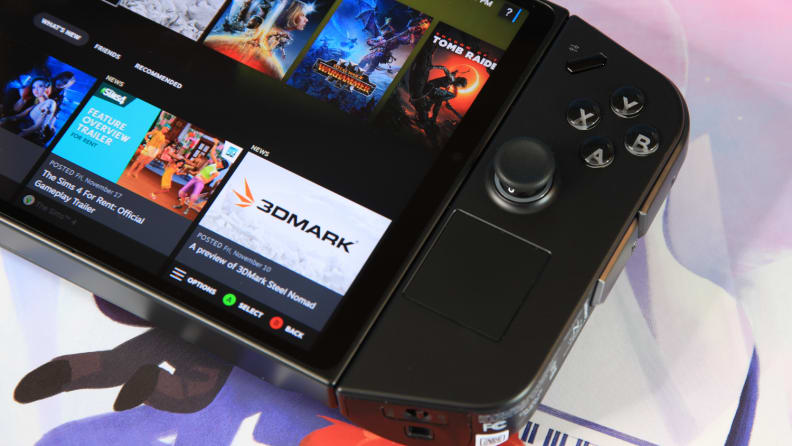
The Legion Go is one of only two PC handhelds to integrate a trackpad.
Maybe, if you don’t plan to go anywhere with the Go
The Lenovo Legion Go is defined by its 8.8-inch, 1440p display. Its sheer size delivers a level of immersion not found on other handhelds. It’s speedy, too, delivering performance that can match the Asus ROG Ally Z1 Extreme and beat the Steam Deck OLED.
But the large display’s size makes the Legion Go heavier and thicker than the competition. Battery life isn’t great, either, despite a relatively large 49.2-watt-hour battery. These downsides remove the “Go” from the Legion Go. It’s not comfortable to use in cramped spaces and becomes tiring to hold for long gaming sessions.
That limits the Legion Go’s appeal, but don’t count it out. The Go is at home at home—preferably in a comfortable living room chair. If you plan to travel, the Steam Deck OLED is a much better choice.

The Lenovo Legion Go beats its handheld PC competitors on screen size, resolution, and refresh rate.
Meet the tester
Matthew S. Smith is a veteran tech journalist and general-purpose PC hardware nerd. Formerly the Lead Editor of Reviews at Digital Trends, he has over a decade of experience covering PC hardware. Matt often flies the virtual skies in Microsoft Flight Simulator and is on a quest to grow the perfect heirloom tomato.
Checking our work.
Our team is here for one purpose: to help you buy the best stuff and love what you own. Our writers, editors, and lab technicians obsess over the products we cover to make sure you're confident and satisfied. Have a different opinion about something we recommend? Email us and we'll compare notes.
Shoot us an email

